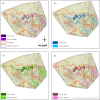Targeting Sagebrush (Artemisia Spp.) Restoration Following Wildfire with Greater Sage-Grouse (Centrocercus Urophasianus) Nest Selection and Survival Models
- PMID: 35687203
- PMCID: PMC9252971
- DOI: 10.1007/s00267-022-01649-0
Targeting Sagebrush (Artemisia Spp.) Restoration Following Wildfire with Greater Sage-Grouse (Centrocercus Urophasianus) Nest Selection and Survival Models
Abstract
Unprecedented conservation efforts for sagebrush (Artemisia spp.) ecosystems across the western United States have been catalyzed by risks from escalated wildfire activity that reduces habitat for sagebrush-obligate species such as Greater Sage-Grouse (Centrocercus urophasianus). However, post-fire restoration is challenged by spatial variation in ecosystem processes influencing resilience to disturbance and resistance to non-native invasive species, and spatial and temporal lags between slower sagebrush recovery processes and faster demographic responses of sage-grouse to loss of important habitat. Decision-support frameworks that account for these factors can help users strategically apply restoration efforts by predicting short and long-term ecological benefits of actions. Here, we developed a framework that strategically targets burned areas for restoration actions (e.g., seeding or planting sagebrush) that have the greatest potential to positively benefit sage-grouse populations through time. Specifically, we estimated sagebrush recovery following wildfire and risk of non-native annual grass invasion under four scenarios: passive recovery, grazing exclusion, active restoration with seeding, and active restoration with seedling transplants. We then applied spatial predictions of integrated nest site selection and survival models before wildfire, immediately following wildfire, and at 30 and 50 years post-wildfire based on each restoration scenario and measured changes in habitat. Application of this framework coupled with strategic planting designs aimed at developing patches of nesting habitat may help increase operational resilience for fire-impacted sagebrush ecosystems.
Keywords: Cheatgrass; Decision-support tool; Habitat restoration; Nest survival; Sagebrush; Wildfire.
© 2022. This is a U.S. Government work and not under copyright protection in the US; foreign copyright protection may apply.
Conflict of interest statement
The authors declare no competing interests.
Figures



References
-
- Arkle RS, Pilliod DS, Hanser SE, Brooks ML, Chambers JC, Grace JB, Knutson KC, Pyke DA, Welty JL, Wirth TA. Quantifying restoration effectiveness using multi-scale habitat models: implications for sage-grouse in the Great Basin. Ecosphere. 2014;5(3):31. doi: 10.1890/ES13-00278.1. - DOI
Publication types
MeSH terms
LinkOut - more resources
Full Text Sources
Medical
Miscellaneous

